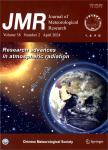Characteristics of Boundary Layer Structure during a Persistent Haze Event in the Central Liaoning City Cluster, Northeast China
Characteristics of Boundary Layer Structure during a Persistent Haze Event in the Central Liaoning City Cluster, Northeast China作者机构:Institute of Atmospheric Environment China Meteorological Administration Shenyang 110166 Shenyang Regional Climatic Center Shenyang 110166 Laboratory for Climate and Ocean-Atmosphere Studies Department of Atmospheric and Oceanic Sciences School of Physics Peking University Beijing 100871
出 版 物:《Journal of Meteorological Research》 (气象学报(英文版))
年 卷 期:2018年第32卷第2期
页 面:302-312页
核心收录:
学科分类:07[理学] 070602[理学-大气物理学与大气环境] 0706[理学-大气科学]
基 金:Supported by the National Key R&D Program of China(2016YFC0203304) Science and Technology Research Project(Doctoral Research Special Fund)of Liaoning Meteorological Office(D201603) National Natural Science Foundation of China(41375146 and41605081) China Meteorological Administration Special Public Welfare Research Fund(GYHY201406031) Basic Research Funds of Central Public Welfare Research Institutes(2016SYIAEZD3) China Meteorological Administration Special Funds for Core Business Development(CMAHX20160306)
主 题:haze event thermal inversion layer atmospheric boundary layer Northeast China
摘 要:The characteristics of boundary layer structure during a persistent regional haze event over the central Liaoning city cluster of Northeast China from 16 to 21 December 2016 were investigated based on the measurements of particulate matter(PM) concentration and the meteorological data within the atmospheric boundary layer(ABL). During the observational period, the maximum hourly mean PM_(2.5) and PM10 concentrations in Shenyang, Anshan, Fushun, and Benxi ranged from 276 to 355 μg m–3 and from 378 to 442 μg m–3, respectively, and the lowest hourly mean atmospheric visibility(VIS) in different cities ranged from 0.14 to 0.64 km. The central Liaoning city cluster was located in the front of a slowly moving high pressure and was mainly controlled by southerly winds. Wind speed(WS) within the ABL(〈 2 km) decreased significantly and WS at 10-m height mostly remained below 2 m s–1 during the hazy episodes, which was favorable for the accumulation of air pollutants. A potential temperature inversion layer existed throughout the entire ABL during the earlier hazy episode [from 0500 Local Time(LT) 18 December to 1100 LT 19 December], and then a potential temperature inversion layer developed with the bottom gradually decreased from 900 m to 300 m. Such a stable atmospheric stratification further weakened pollutant dispersion. The atmospheric boundary layer height(ABLH) estimated based on potential temperature profiles was mostly lower than 400 m and varied oppositely with PM_(2.5) in Shenyang. In summary, weak winds due to calm synoptic conditions, strong thermal inversion layer, and shallow atmospheric boundary layer contributed to the formation and development of this haze *** backward trajectory analysis revealed the sources of air masses and explained the different characteristics of the haze episodes in the four cities.



